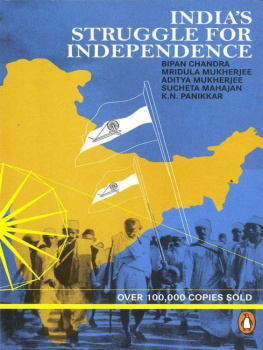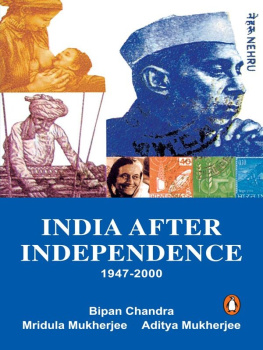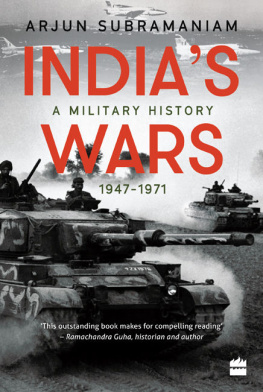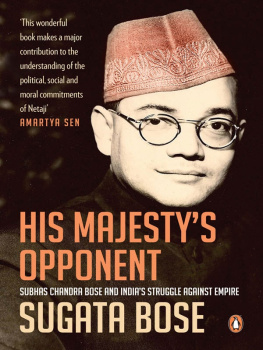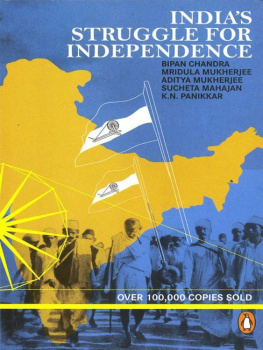Chandra Bipan - Indias struggle for independence, 1857-1947
Here you can read online Chandra Bipan - Indias struggle for independence, 1857-1947 full text of the book (entire story) in english for free. Download pdf and epub, get meaning, cover and reviews about this ebook. City: Delhi, year: 2000;2017, publisher: Penguin Books Ltd, genre: Politics. Description of the work, (preface) as well as reviews are available. Best literature library LitArk.com created for fans of good reading and offers a wide selection of genres:
Romance novel
Science fiction
Adventure
Detective
Science
History
Home and family
Prose
Art
Politics
Computer
Non-fiction
Religion
Business
Children
Humor
Choose a favorite category and find really read worthwhile books. Enjoy immersion in the world of imagination, feel the emotions of the characters or learn something new for yourself, make an fascinating discovery.
- Book:Indias struggle for independence, 1857-1947
- Author:
- Publisher:Penguin Books Ltd
- Genre:
- Year:2000;2017
- City:Delhi
- Rating:5 / 5
- Favourites:Add to favourites
- Your mark:
- 100
- 1
- 2
- 3
- 4
- 5
Indias struggle for independence, 1857-1947: summary, description and annotation
We offer to read an annotation, description, summary or preface (depends on what the author of the book "Indias struggle for independence, 1857-1947" wrote himself). If you haven't found the necessary information about the book — write in the comments, we will try to find it.
Indias struggle for independence, 1857-1947 — read online for free the complete book (whole text) full work
Below is the text of the book, divided by pages. System saving the place of the last page read, allows you to conveniently read the book "Indias struggle for independence, 1857-1947" online for free, without having to search again every time where you left off. Put a bookmark, and you can go to the page where you finished reading at any time.
Font size:
Interval:
Bookmark:


MRIDULA MUKHERJEE
ADITYA MUKHERJEE
K.N. PANIKKAR
SUCHETA MAHAJAN
STRUGGLE FOR
INDEPENDENCE
1857-1947


5. Foundation of the Indian National Congress:
The Reality
11. The Split in the Congress and the Rise of
Revolutionary Terrorism
19. The Years of StagnationSwarajists, No-Changers and
Gandhiji
20. Bhagat Singh, Surya Sen and the Revolutionary
Terrorists
39. The Indian National Movement: The Ideological
Dimension
5. Foundation of the Indian National Congress:
The Reality
6. Socio-Religious Reforms and the National
Awakening
11. The Split in the Congress and the Rise of
Revolutionary Terrorism
17. The Indian Working Class and the National
Movement
18. The Struggles for Gurdwara Reform and Temple
Entry
19. The Years of StagnationSwarajists, No-Changers
and Gandhiji
20. Bhagat Singh, Surya Sen and the Revolutionary
Terrorists
39. The Indian National Movement: The Ideological
Dimension
PENGUIN BOOKS
BIPAN CHANDRA was born in Kangra, Himachal Pradesh. He was educated at Forman Christian College, Lahore and at Stanford University, California. He was Professor of Modern History at Jawaharlal Nehru University (JNU), New Delhi, where he is currently Professor Emeritus. He has recently been honoured as National Professor and is also the Chairperson of the National Book Trust. Professor Chandra is the author of several books on nationalism, colonialism and communalism in modern India.
MRIDULA MUKHERJEE was educated at Lady Shri Ram College, New Delhi and at JNU. She is Professor of Modern Indian History at the Centre for Historical Studies, JNU and Director, Nehru Memorial Museum and Library. Her areas of special interest are agrarian history, peasant movements and the national movement.
ADITYA MUKHERJEE was educated at St. Stephens College, Delhi, and at JNU. He is Professor of Contemporary Indian History at the Centre for Historical Studies, JNU and Director, Jawaharlal Nehru Institute of Advanced Studies. His research interests are in modern business history and capitalist development, and contemporary economy and politics.
K. N. PANIKKAR was educated at the Madras and Rajasthan Universities. He was professor of Modern Indian History at the Centre for Historical Studies, JNU and Vice Chancellor, Shri Shankaracharya University, Kalady, Kerala. He is currently Chairman, Kerala Council for Historical Research and Vice Chairman, Higher Education Council, Government of Kerala. He has published widely in the areas of cultural and intellectual history and agrarian history.
SUCHETA MAHAJAN was educated at Indraprastha College, Delhi and JNU. She is Professor at the Centre for Historical Studies, JNU and Chairperson, P.C. Joshi Archives on Contemporary History, JNU. Her research focus has been on the political process in India in the 1940s, including independence and partition, popular struggles and the issues that occupied the last phase of Mahatma Gandhis life.
In order to ensure the continuity of the books narrative the authors of the various chapters are mentioned here and nowhere else in the volume. The Introduction and Chapters 2, 3, 4, 5, 7, 8, 9, 11, 18, 19, 20, 23, 24, 25, 26, 30, 31, 32, 33, 34, 38 and 39 have been written by Bipan Chandra; Chapters 1 and 6 have been written by K.N. Panikkar; Chapters 10, 17 and 29 have been written by Aditya Mukherjee; Chapters 12, 13, 14, 15, 16, 21, 22, 27, 28 and 35 have been written by Mridula Mukherjee; and Chapters 36 and 37 have been written by Sucheta Mahajan.
To Romila Thapar and S. Gopal
The Indian national movement was undoubtedly one of the biggest mass movements modern society has ever seen. It was a movement which galvanized millions of people of all classes and ideologies into political action and brought to its knees a mighty colonial empire. Consequently, along with the British, French, Russian, Chinese, Cuban and Vietnamese revolutions, it is of great relevance to those wishing to alter the existing political and social structure.
Various aspects of the Indian national movement, especially Gandhian political strategy, are particularly relevant to these movements in societies that broadly function within the confines of the rule of law, and are characterized by a democratic and basically civil libertarian polity. But it is also relevant to other societies. We know for a fact that even Lech Walesa consciously tried to incorporate elements of Gandhian strategy in the Solidarity Movement in Poland.
The Indian national movement, in fact, provides the only actual historical example of a semi-democratic or democratic type of political structure being successfully replaced or transformed. It is the only movement where the broadly Gramscian theoretical perspective of a war of position was successfully practised; where state power was not seized in a single historical moment of revolution, but through prolonged popular struggle on a moral, political and ideological level; where reserves of counter-hegemony were built up over the years through progressive stages; where the phases of struggle alternated with passive phases.
The Indian national movement is also an example of how the constitutional space offered by the existing structure could be used without getting co-opted by it. It did not completely reject this space, as such rejection in democratic societies entails heavy costs in terms of hegemonic influence and often leads to isolation but entered it and used it effectively in combination with non-constitutional struggle to overthrow the existing structure.
The Indian national movement is perhaps one of the best examples of the creation of an extremely wide movement with a common aim in which diverse political and ideological currents could co-exist and work and simultaneously continue to contend for overall ideological and political hegemony over it. While intense debate on all basic issues was allowed, the diversity and tension did not weaken the cohesion and striking power of the movement; on the contrary, this diversity and atmosphere of freedom and debate became a major source of its strength.
Today, over forty years after independence, we are still close enough to the freedom struggle to feel its warmth and yet far enough to be able to analyse it coolly, and with the advantage of hindsight. Analyse it we must, for our past, present and future are inextricably linked to it. Men and women in every age and society make their own history, but they do not make it in a historical vacuum, de novo. Their efforts, however innovative, at finding solutions to their problems in the present and charting out their future, are guided and circumscribed, moulded and conditioned, by their respective histories, their inherited economic, political and ideological structures. To make myself clearer, the path that India has followed since 1947 has deep roots in the struggle for independence. The political and ideological features, which have had a decisive impact on post-independence development, are largely a legacy of the freedom struggle. It is a legacy that belongs to all the Indian people, regardless of which party or group they belong to now, for the party which led this struggle from 1885 to 1947 was not then a party but a movement all political trends from the Right to the Left were incorporated in it.
Font size:
Interval:
Bookmark:
Similar books «Indias struggle for independence, 1857-1947»
Look at similar books to Indias struggle for independence, 1857-1947. We have selected literature similar in name and meaning in the hope of providing readers with more options to find new, interesting, not yet read works.
Discussion, reviews of the book Indias struggle for independence, 1857-1947 and just readers' own opinions. Leave your comments, write what you think about the work, its meaning or the main characters. Specify what exactly you liked and what you didn't like, and why you think so.

